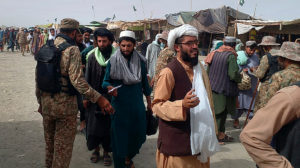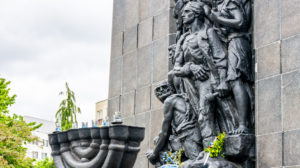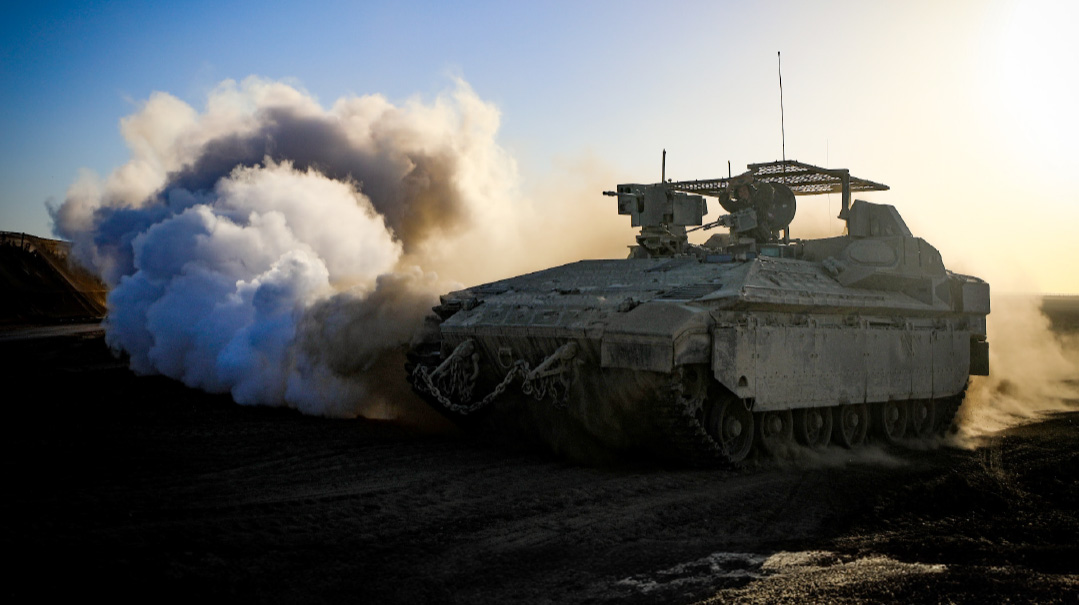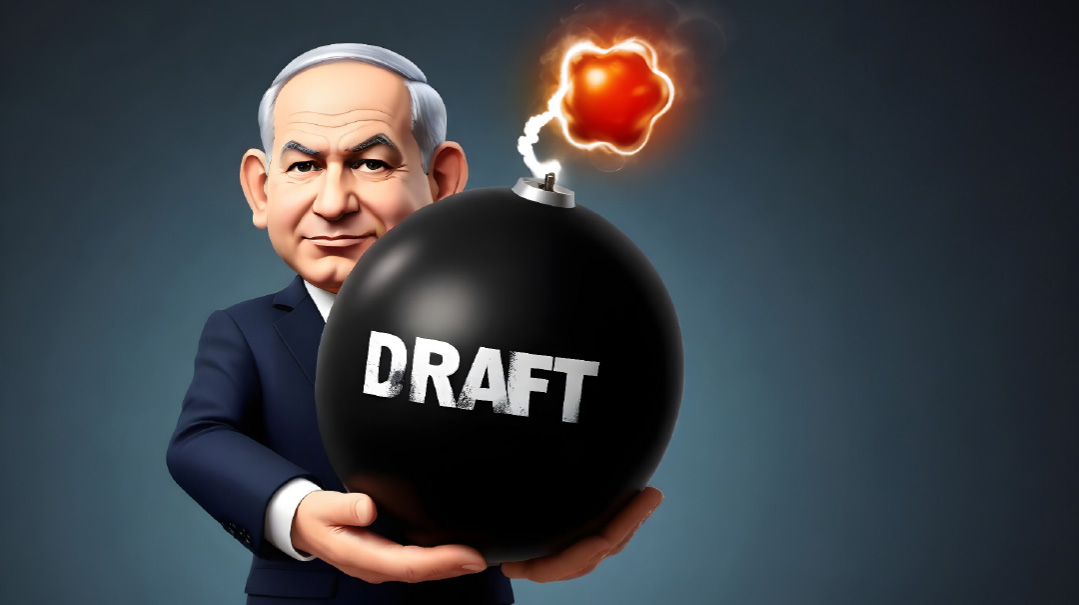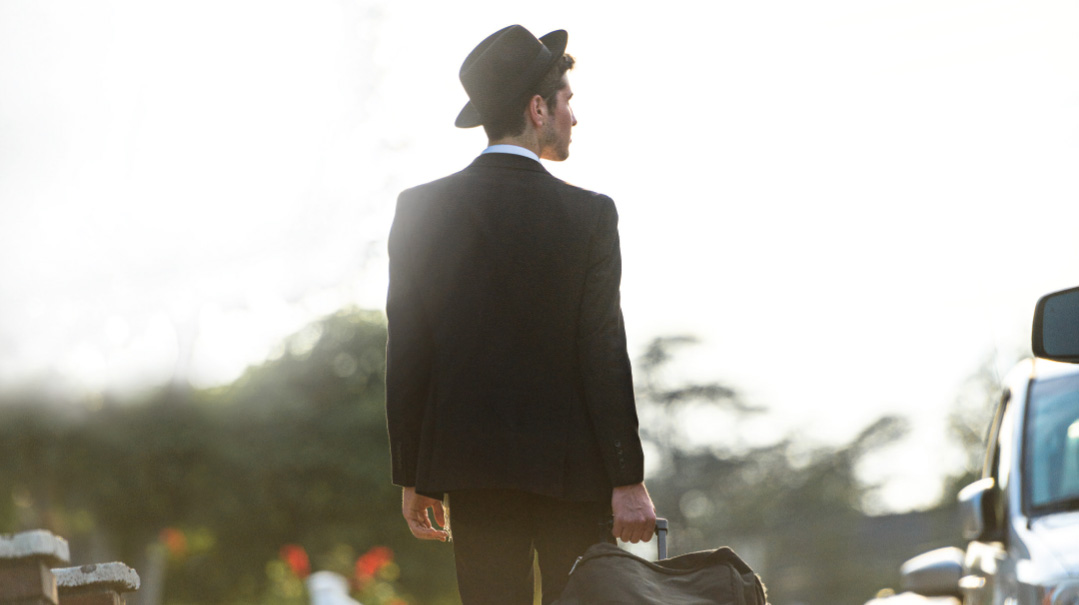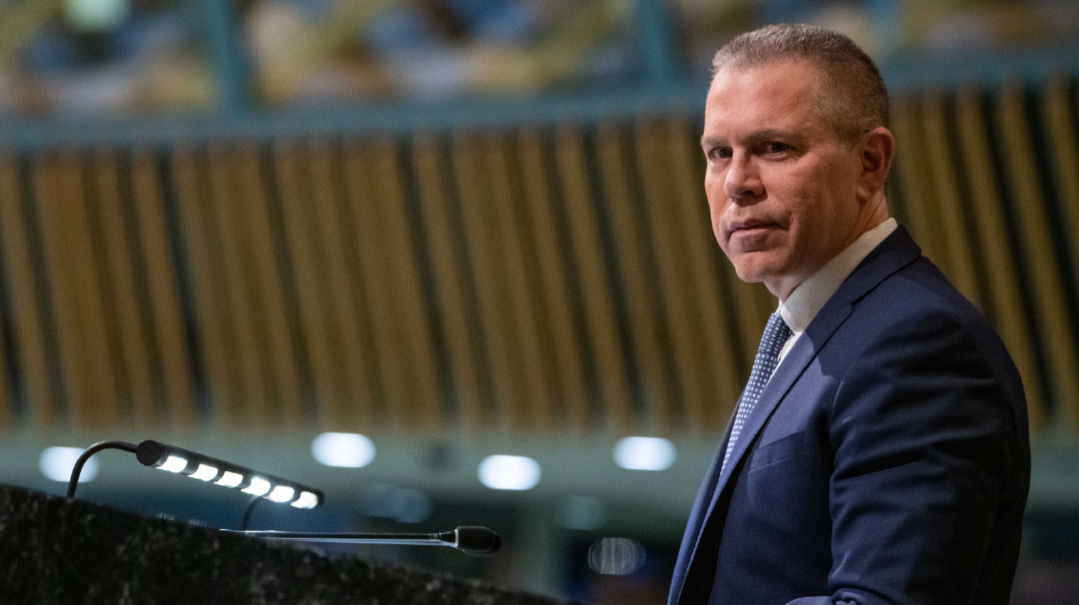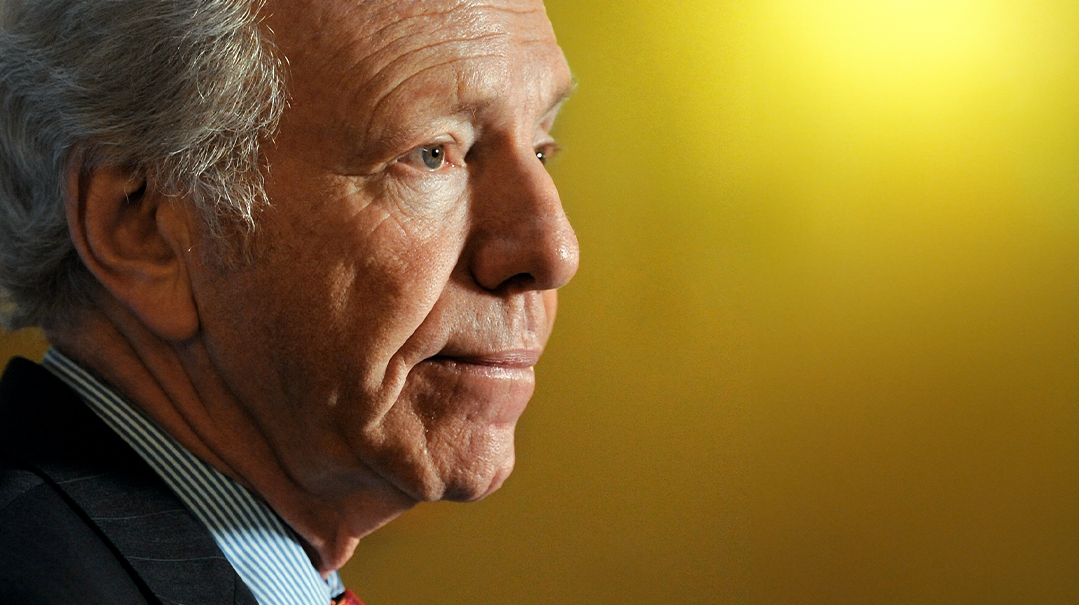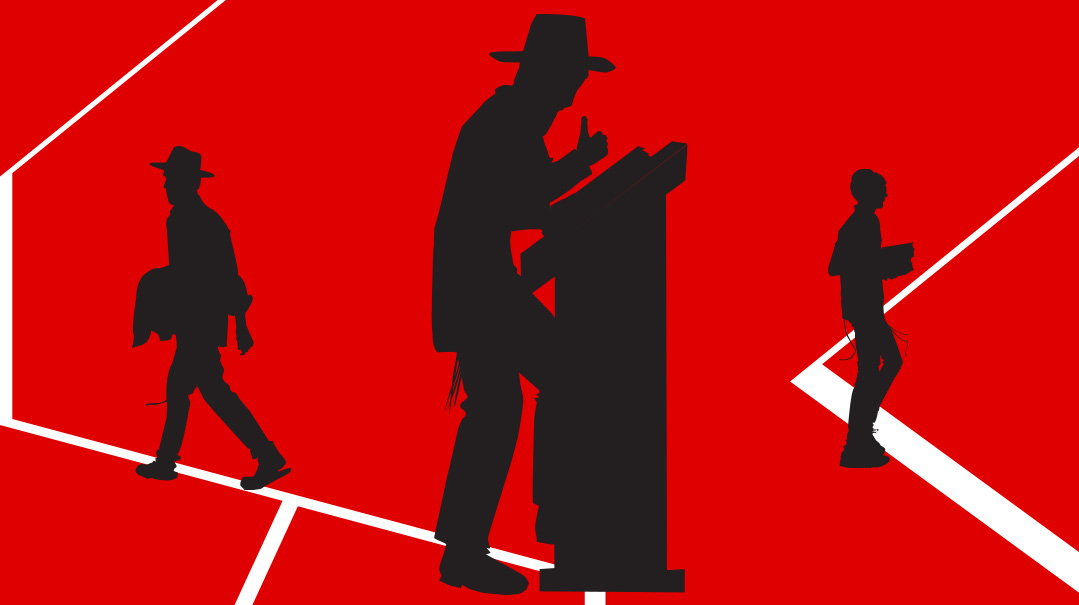Ring of Fire
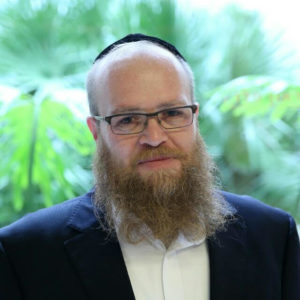
Goodbye coexistence? Israel's Jewish-Arab relationships up in flames
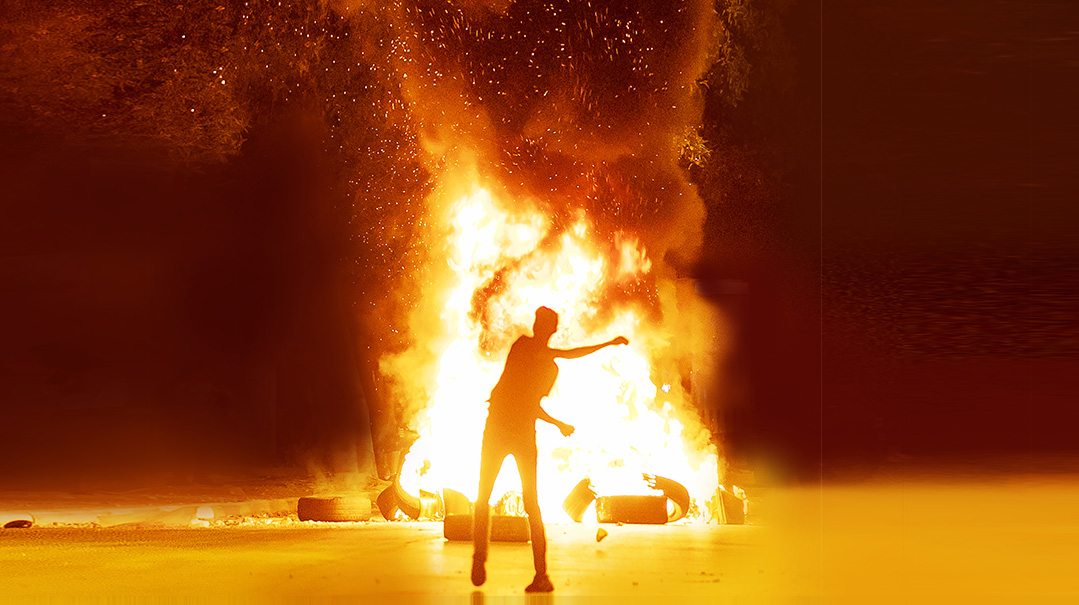
With reporting by Yonaton Birnbaum
It was a night of flames that no one from Lod, a mixed Jewish-Arab city near Tel Aviv, will forget in a hurry. As the sirens wailed last Tuesday and passersby ran for cover, the sky was alight with dueling Qassam rockets and Iron Dome interceptors, and the earth burned with the light of torched cars as an Arab mob rampaged.
“My hometown has turned into a battlefield” was the thought that flashed through my mind as I passed masked Arab gangs just five minutes from my home. Lod has always been a mixed city, home to both Jews and Israeli Arabs. But the scenes I was now witnessing were the furthest thing from the quiet coexistence of the past. With stones in their hands, the Arabs seized control points, blocked roads by lighting fires, and vented their anger on parked vehicles, security cameras, and road signs. And the police were barely visible. Here and there, I saw lone policemen with helmets on their heads walking around the area.
By morning the damage was evident, and it was shocking: Synagogues had suffered deliberate vandalism, the windows of a religious articles store were shattered, and part of the city’s new cemetery was ravaged by fire.
The night’s events were repeated in a string of mixed-population cities from Haifa to Jaffa, Ramle to Teveria. But what happened in Lod was so severe that even President Ruby Rivlin — a right-winger who’s made Arab-Jewish coexistence his signature project — called it by its name.
“What happened last night was a pogrom by a bloodthirsty Arab mob,” he said in a statement of unprecedented severity, calling the silence of Arab leadership over the events “shameful” and “encouraging the rupture of the society in which we live.”
But the violence from within is only part of the picture. Even as Israel’s Jewish population was left reeling by the savagery of the uprising — amid what looked like the onset of a third Intifada — an external enemy was pounding at the gates. With nonstop volleys of rockets aimed at Jerusalem and Tel Aviv along with its usual targets closer to Gaza, Hamas had put itself firmly back at the top of Israel’s agenda.
Israel’s most recent descent into conflict with Gaza is a classic case of throwing a match into a gas tank: after a series of increasingly violent incidents, the Arab street was primed to explode. Incited Arab youth attacking Jews in so-called “TikTok terror”; a dispute over Jewish people moving into the flashpoint Sheikh Jarrah neighborhood in Jerusalem; then the riots over Har HaBayis as Ramadan came to a close — all raised the temperature to an inevitable boiling point.
Whatever the immediate trigger for the descent to open conflict, as the IDF masses troops on Gaza border amid mounting international pressure on Israel to call a cease-fire, the full extent of Israel’s strategic dead-end has come into focus. Hamas may lack the power of the full IDF arsenal, but it makes disproportionate gains by terrorizing an entire civilian population and playing the international media like a seasoned maestro. In the absence of a viable alternative to Hamas’s rule in Gaza given the unpopularity of Mahmoud Abbas’s Fatah Party, overthrowing Hamas in a bloody incursion is off the table. But in government, the terror outfit continues to grow more deadly, making an eventual reckoning more dangerous.
And in parallel, the group’s prestige on the Arab-Israeli street continues to grow.
Israel has unfortunate experience dealing with missile volleys from Hamas, but the double blows of missile strikes from without along with violence from within makes the terrain much more treacherous to navigate. Even cities known for coexistence among Arab and Jewish populations have been overturned by violence, destruction, and outright hatred. As one of Israel’s most complex mixed cities becomes a place of terror for Jews, coexistence in my hometown of Lod is impossible unless Israel’s leaders take back control. Unless Israel manages to change the equation and break Hamas, the terror chiefs of Gaza will continue to fire at Israel’s population and rule Israel’s streets.
War Zone
Battle smoke billows over Exodus Street in the Ramat Eshkol neighborhood of Lod. The day after the pogrom, burned-out cars line the street, and the ground is strewn with rocks, sticks, and street signs torn out of the pavement. Two border police vans are parked at the side of the street, opposite the building housing the educational institutions of the Garin Torani — the national-religious community — in Lod, part of the Maoz network.
The courtyard between the institution’s buildings is full of people who’ve come to see the scene for themselves and give residents encouragement and reassurance.
“They weren’t here at nine o’clock last night, when the pogrom started,” says one resident bitterly, indicating the police vans. “They didn’t arrive till long after midnight.”
After introducing himself as Ariel Kochav, he adds: “Early in the evening when the noise started, I spoke with one of the police commanders and he told me they would be on patrol and there was nothing to worry about. I asked him: ‘Everything’s under control?’ He said: ‘Yes, no worries.’”
Standing nearby is a young couple holding a small child. When I ask them how they’re holding up, I find out that they’re about to leave anyway. “It has nothing to do with the security situation. It’s just that our apartment is small, so we’re moving to a moshav.” I’ll hear the same claim from at least two more couples.
They excuse themselves and turn to address a man who has just entered the yard. “Can you promise us that tonight will be quieter?” the woman pleads. “I’m really scared.”
The man is none other than general director of the Lod municipality Aharon Atias, formerly the director of the Garin Torani. Atias nods sympathetically. He doesn’t seem to have any real answers.
It’s hard for the residents to believe what happened the night before. In the wake of Hamas rocket fire and the riots at the Temple Mount, hundreds of their neighbors — Arab residents of Lod — went out into the streets and rioted violently. The mob threw rocks at Jewish cars and police, shot fireworks, set dumpsters on fire, tore down Israeli flags and replaced them with Palestinian flags. At the height of the clashes, a Jewish resident of the city opened fire on the mob, killing a 25-year-old Arab rioter and moderately wounded two others. The next day, after a quick investigation by the Shfela crime prevention unit, police arrested a 34-year-old man suspected of carrying out the shooting. After a security consultation between Internal Security Minister Amir Ohana and Police Commissioner Kobi Shabtai, it was decided to mobilize eight more units of border police reserves to reinforce security forces in the city.
Up in Flames
The faces of the people standing here display a mix of frustration, disappointment, anger, and most of all — fear for the future. Across the street lies a long residential building. Israeli flags droop dolefully from some of the balconies. “It’s a mixed building,” explains Harel, who lives in it himself.
When I ask how Jews and Arabs can get along in such close proximity he sighs. “Until now it was fine,” he says. And now? I press him. “Not anymore, apparently.” And how did his Arab neighbors react to the riots yesterday? “It didn’t seem to bother them. Some people in the building even said they heard them laughing and enjoying the spectacle. A few went down into the street to make sure their cars weren’t torched, to let the rioters know they belonged to Arabs.” So can we say goodbye to the dream of coexistence? “No one knows.”
Inside the building, the Talmud Torah is teeming with life: staff members, reporters from various TV channels, concerned parents, or just curious spectators. School was closed this morning, though not necessarily because of yesterday’s riots — many schools considered to be in vulnerable areas were ordered closed by the home front command, because of the missile volleys from Gaza.
“It’s a great siyata d’Shmaya that there’s no school today,” one father tells me earnestly. “This sight is the last thing we want our kids to see.”
He’s right. The scene is hard to look at. The walls and stairs are covered in soot. In the lobby, two girls are trying to scrub away the ashes, and maybe the trauma as well.
One flight up, I come face to face with the aftereffects of the pogrom. There’s no other word for what I see here. The classrooms are burnt and blackened, the chairs and tables are turned over in disarray, and the schoolbooks, including sifrei kodesh, are scattered on the floor charred and torn.
“Some of the students who insisted on seeing what happened left in tears,” one parent told me.
In the corridor stand the school principal Rabbi Yechezkel Cohen and his assistant, leaning silently on the window. From time to time their eyes wander outside, as if seeking help.
“We have to find a different location,” the menahel says in an optimistic tone, as if he believes school can continue next day.
“There’s no choice, we’ll have to go back to long-distance learning,” says his assistant more realistically.
Next to them, along the hallway, lies a table covered in displays prepared by the students in honor of Yom Yerushalayim. Now they’re standing forlorn on the table, looking anything but festive.
I ask Rabbi Cohen, who’s been menahel of the Talmud Torah for eight years but only moved to Lod last year, to share his thoughts.
“Look, I’ve seen disturbances in this country before, but never anything like yesterday,” he says. “Residents from across the street could only watch helplessly as 150 Arab rioters broke through the gate, vandalized the building, and set it on fire. Police were called, but failed to show up. After midnight one mother who lives in the building across the street called to inform me that the building was in flames.”
Is he planning to leave the city? “No, of course not. It’s true that this is a very grim sight, but b’ezras Hashem we’ll soon open new classes. Ramat Eshkol used to be a Jewish neighborhood, now it’s mostly Arab. No one ever imagined anything like this. But it’s a long way from this to abandoning our homes.”
How were relations with the Arab neighbors until now? “Look, it’s not like we went flower-picking together, but we got alone fine. We even have some Arab employees here at the school. In the past two months,” he reflects, “there was a certain tension in the air. Here and there a rock was thrown and there were some minor fights, but no one dreamed that it would come to this. Now the parents are frightened, the children are frightened, we have to think long and hard about how to proceed from here.”
A Complex Place
I leave the building of the Talmud Torah and head over to the Maoz pre-military preparatory academy, a high school framework for national-religious boys planning to combine Torah study with army service. It’s the same scene.
A strong smell of fire, the entrance gates are broken, and shards of glass are everywhere. The heichal of the beis medrash is empty. The tables hold charred siddurim and Gemaras. Here too, I sense echoes of Kristallnacht.
A group of kids with mops are scrubbing black stains from the floor. The oldest one walks around with a bucket pouring out water and soap for everyone who needs it.
“Why don’t you have a magav?” one boy asks another, using the Hebrew word for a mop.
“Don’t you know there’s a shortage of magav here?” answers the other, in a cynical play on words — “magav” is also the acronym for the border police, who failed abysmally at subduing the riots.
Eitan, a 19-year-old student of the academy, walks between the tables, wiping the seforim with a damp rag and trying to restore some order and dignity to the beis medrash. At the other end of the beis medrash are three students from Beit El who volunteered to come and help.
“It’s a big miracle that we weren’t here last night,” Eitan tells me. “We were all in Jerusalem celebrating Yom Yerushalayim. Truth is that we debated whether to go back, but we decided to stay the night in Jerusalem. It turned out to be the right choice. If we had been here, there’s little doubt that this would have ended in a much greater tragedy.”
The father of one of the students calls out: “Everyone has to leave now. The funeral of the Arab who was killed yesterday is passing by outside soon.”
Outside, dozens of border police are already taking up positions on both sides of the street. Before the funeral procession arrives, I try to get a better sense of the vanishing coexistence in the city. “Talk to her,” the residents suggest, pointing to Ms. Rina Bloch, a resident who moved here from Jerusalem less than a year ago.
Why did you leave Jerusalem for Lod? I ask.
“I realize it sounds strange now,” she says, “but actually, there’s a strong and vibrant Torah community here. Lod lies right in the heart of the country, close to Highway 6, the train station, Ben-Gurion Airport. I’m not denying that in the past few years it’s become a complex place, and anyone who could afford to leave left. But we wanted to be here, to support the families that can’t afford the move, to keep their morale up. Today this neighborhood is split 50-50 between Jews and Arabs.”
Mrs. Bloch admits that Lod wasn’t a paradise. “On the whole, the socio-economic status of this neighborhood is low, in both sectors. So we’ve always had a bit of a crime problem. Just two months ago a car exploded across the street in the middle of the day. But it wasn’t an ethnic issue. We had a sort of coexistence. We went to the same parks, had extracurricular activies in the same community centers. Their muezzin blares out five times a day and we have music playing before Shabbos.”
On Succos, she says, all the Jews celebrate openly in their succahs. “Some Arab neighbors would wish us a chag sameiach, others would ignore us. But there was also this fragile sense of calm.”
So what happened yesterday to cause such a drastic change? “Very simple,” she says. “They came out the mosque completely incited — old and young, women and children — and started chanting, ‘With blood and fire we’ll redeem Palestine.’ Then they started rioting and you can see the results.”
With the calm irrevocably shattered, she is hearing serious talk of leaving. “People no longer trust the police. But leaving isn’t simple — it really how things go moving forward, and whether our sense of security is restored. Anyone who decides to leave knows that he’s leaving behind those who don’t have it in their power to do so. There are elderly people, people from the Ethiopian community, and poor families that can’t afford to move.”
Despite the destruction, Mrs. Bloch thinks that there are Arabs who genuinely want peace. “They’re afraid to express themselves,” she says, “because the radical Arab leadership is fanning the flames, both on the national and on the local level. I can show you an Arab who parked his car next to his Jewish neighbor’s car so the rioters wouldn’t burn it. Are they all like that? Of course not. Time will tell what will happen. We’ll hope for the best.”
A Growing Stream
However sudden the shock came to the residents of Lod, Ramle and East Jerusalem, a crisis like this has deep roots.
According to Israeli Arab leaders, Israel’s government is to blame. Dr. Samir Suhabi Mahmid, the mayor of Umm El Fahm, declares that violence is not his way — while refusing to condemn the young rioters.
“I don’t agree with those guys who are throwing stones, but I definitely understand them, and where their anger is coming from,” he explains. “It is inconceivable that I could be banished from my mosque. Imagine that a Jew were to be banished from his beit knesset. What you would do? Imagine that a grenade were to be thrown into a beit knesset.”
Dr. Mahmid does not attribute these incidents to a long, slow radicalization process, but rather to a more pinpointed anger tied to current events. “It began in Sheikh Jarrah, and then moved to Damascus Gate, and then to the buses that stop there. The political and police echelons should have been smarter and not caused the unrest. There’s also a housing crisis and mounting violence in our communities. There’s lots of anger within the sector as well. All these frustrations have to erupt somewhere.”
But that view would be angrily contested by the vast majority of Israel’s Jewish population. In the development from random attacks on Jews to Arab rampages, they see the return of Arab Israeli militancy.
A steady feature in the recent riots in East Jerusalem, Sheikh Jarrah and the city of Lod were young Arabs wrapped in Palestinian flags shouting against the government of Israel and in support of the Palestinian nationalist struggle. They are not afraid of clashing with police, nor are they fazed by a few days of incarceration. In fact, they welcome it.
Fomer police commissioner Borowksy believes that this wave of violence is the outcome of years of failure by the state and the police to handle a certain stream within the Israeli Arab population.
“The stream that we see today is a militant one, connected to Balad and other elements,” he says. “They take their instructions not from the local leadership but from terror organizations. It’s a stream that doesn’t recognize the state, and that is actively working and will take advantage of any opportunity to strike wherever it can.”
This stream has always been present among Israeli Arabs, but Borowski thinks that it has grown recently. “This stream is now taking a more central role. The riots are also the result of an inability of the state and the police to deal with them. When the state does not provide services, it loses its power. It loses trust, and the citizen feels that he has no security. People want to see actions and results. Among Israeli Arabs, there need to be 3,000 to 5,000 policemen out on the streets not only during special operations, but every single night, until there is absolute control in the area. If not, the result is the present chaos.”
The gap between the two narratives is underlined by statistics on Israeli Arabs’ own self-identification. According to public opinion surveys conducted by Professor Sammy Smouha of the Haifa University, 22% of Israeli Arabs define themselves as Palestinian Arabs and not as Israelis at all. Another 45% define themselves as Israeli Palestinians, and only 32% define themselves the way the Jewish majority prefers to call them, “Israeli Arabs.”
The events of last Tuesday in Lod and across the country exposed the depth of the rift between Jews and Arabs in Israel. Beneath the surface, many Jews suspect Israeli Arabs of being potential traitors, and the data shows that a significant proportion of Israeli Arabs in fact identify with the Palestinian cause.
The Long Arm of Hamas
The salvos of rockets that streaked skyward from Gaza’s subterranean weapons storehouses were the culmination of Hamas’s plan to humiliate Israel and gain international legitimacy.
But there was a more immediate trigger, says Dr. Kobi Michael, a senior research fellow at the Institute for National Security Studies. He tells Mishpacha that the cancellation of the scheduled elections in the Palestinian Authority, which Hamas anticipated as its long-awaited chance for control of the PA and even a measure of international legitimacy, is what led Hamas to seek to inflame tensions in East Jerusalem.
According to Dr. Michael, the riots that sparked the conflict weren’t spontaneous but rather were the fruit of lengthy planning, with Hamas preparing the ground and arranging for rocks and Molotov cocktails to be smuggled to the Temple Mount. The choice of Jerusalem was made to rile up religious sentiment among the entire Arab population and to hamper Israel’s freedom of operations.
But Hamas’s transparent efforts to draw Israel into conflict have led to a paradigm shift in the way the Israeli leadership views the Hamas terrorist group, a high-ranking IDF commander tells Mishpacha.
“For years Hamas has incited Israeli Arabs against the state,” he says. “Raed Salah, the head of the northern branch of the Islamic Movement in Israel, visits the Bedouins in the Negev more than Taiba or his hometown of Umm El Fahm. He and his men never stop working to inflame tensions, investing considerable financial resources to spread their incitement as far as they can.”
These lines were written even as another heavy barrage of missiles was fired at cities in central Israel. According to major general Guy Tzur (res.), former chief of the IDF Ground Forces Command, the current fighting is a direct result of allowing the problem of Gaza to fester like an open sore.
“In the past, Netanyahu opted for a strategy of short rounds of combat with Hamas, even though Israel paid a heavier price with each consecutive round,” he says. “He refused to accept the warnings of the Shin Bet and the IDF’s military intelligence directorate regarding the growth of Hamas and the impossibility of negotiating or reaching long-term agreements with the group.”
Three weeks ago, after 36 rockets and shells were fired from the strip, the IDF recommended an extensive military operation, but the suggestion was blocked by Israel’s political leadership.
Israel also refrained from responding to incendiary balloons launched from Gaza and ignored the burnings of fields in the Gaza envelope, as well as Hamas’s threats of missile fire — it even granted Hamas significant concessions. In the past, General Tzur says, these provocations would draw retaliatory airstrikes from the IAF.
Two weeks ago, Israel allowed Qatar to transfer its monthly bonanza to Gaza despite the security tensions. On one night, millions of dollars were transferred into Gaza through the Erez crossing. Some 100,000 Palestinian families received $10 million in cash.
But Israel reacted swiftly and confidently to last week’s escalation. It took Israel much less than 24 hours to send a clear message that it views rocket fire as nothing less than a declaration of war. Israel made clear to mediators (from the United States, Egypt, the EU, and Qatar) that it refuses to end the current operation, dubbed “Guardian of the Walls,” until Hamas and other militant groups get the message.
But however the current fighting ends, does Israel have a real strategy to defeat the Gazan terrorists, or is this just another periodic bloodletting that may make Hamas bleed, but won’t bring it to its knees?
“There will be no draw here,” predicts Colonel Moshe Elad (res.), who formerly served as head of the Regional Security Committee (RSC) and its coordinator to the Palestinian Authority. “Either the sovereign state of Israel will bring this group to its knees or Hamas will emerge with the upper hand.”
According to him, Israel sees the Hezbollah playbook in Hamas’s recent actions. The heads of Hamas, like Nasrallah in his day, gave Israel an ultimatum and when Israel ignored it, they made good on their word and fired rockets at the Israeli capital.
“Hamas has clearly adopted Hezbollah’s modus operandi. One of their principles is not to make a threat unless you’re prepared to carry it out. The group’s ultimatum to Israel about withdrawing from Sheikh Jarrah and the Temple Mount, as well as the release of the Palestinians arrested in the recent riots — these set a precedent in the history of the mutual deterrence between the terror group and the State of Israel,” says Elad.
Point of No Return
As Israeli jets shared airspace with outgoing Hamas missiles and civil war had descended on Israel’s flashpoint mixed neighborhoods, Naftali Bennett’s belated statement, that the “change coalition” meant to include Islamists was off the table, was only an admission of the obvious.
It was a measure of how far the pogrom of Lod, Ramle, and Haifa has set Israel back. The Gaza 2021 war has let the genie of Arab-Jewish strife out of the bottle, and there’s no knowing where this will stop.
Will it segregate mixed cities, with Jewish residents fleeing the violence as police stand by powerless? Will the delicate fabric of coexistence be torn further by a cycle of vigilantism and revenge?
As Lod’s residents sweep up the broken glass under the watchful eye of Border Police phalanxes, only one thing is sure.
As long as the terror bosses in Gaza are free to decide when missiles fly over the Azrieli Towers, or Israel’s streets burn, nothing will stop the country’s Jewish-Arab tension from climbing unabated toward the point of no return.
(Originally featured in Mishpacha, Issue 861)
Oops! We could not locate your form.




